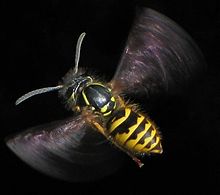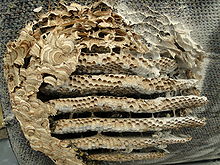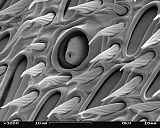- Vespula vulgaris
-
Vespula vulgaris 
Scientific classification Kingdom: Animalia Phylum: Arthropoda Class: Insecta Order: Hymenoptera Suborder: Apocrita Family: Vespidae Genus: Vespula Subgenus: (Paravespula) Species: V. vulgaris Binomial name Vespula vulgaris
(Linnaeus, 1758)The common wasp, Vespula vulgaris, known in the US as the yellowjacket, is found in much of the Northern Hemisphere and has been introduced to Australia and New Zealand. It is a eusocial vespid which builds its grey paper nest in or on a structure capable of supporting it. Underground it often uses an abandoned mammal hole as a foundation for the site which is then enlarged by the workers. The foundress queen may also select a hollow tree, wall cavity or rock crevice for a nest site.
Contents
Identification
Adult workers of the common wasp measure about 12-17 mm (0.5-0.7 in) from head to abdomen,[1] whereas the queen is about 20 mm (0.8 in) long. It has aposematic colours of black and yellow and is very similar to the German wasp (or European wasp, Vespula germanica) but seen head on, its face lacks the three black dots characteristic of that species. Additionally it can be distinguished by a lack of black dots on its back (gastral terga), which are located further up and form part of the black rings on each of the abdomen's six segments. Furthermore the genal area – the part of the head to which the jaws of an insect are attached – is usually broken by black (although sometimes narrowly).[2]
Common wasps are colloquially known as "jaspers" in certain regions of England (such as Dorset and Lincolnshire, and more commonly the English Midlands), although it is not clear whether the etymology refers to the Latin name "vespa" or the striped abdomen, which echoes the striped mineral jasper.
Nest and life cycle
 Larval cells — the covered cells contain larvae undergoing metamorphosis
Larval cells — the covered cells contain larvae undergoing metamorphosis
The nest is made from chewed wood fibres mixed with saliva. It has open cells and a cylindrical column known as a "petiole" attaching the nest to the substrate. The wasps produce a chemical which repels ants and secrete it around the base of the petiole in order to avoid ant predation. A solitary female queen starts the nest, building 20–30 cells before initial egg-laying. This phase begins in spring, depending on climatic conditions. She fashions a petiole and produces a single cell at the end of it. Six further cells are then added around this to produce the characteristic hexagonal shape of the nest cells. One egg is laid in each cell and as it hatches each larva holds itself in the vertical cell by pressing its body against the sides. The queen now divides her time between feeding the larvae on the juices of masticated insects and nest building.[3] Once the larva reaches full size it spins a cover over the cell, pupates and metamorphosises into an adult. When enough adult workers have emerged they take up most of the colony’s foraging, brood care and nest maintenance. The queen, who is now fed by the workers, concentrates all her energy on reproduction.[3] The spherical nest is built from the top downwards with successive combs of cells separated by petioles.[4] The queen larvae, known as "gynes", are reared in larger cells in the lower combs.[4] The finished nest may contain 5,000–10,000 individuals.[3]
Each wasp colony includes one queen and a number of sterile workers. Colonies usually last only one year, with all but the queen dying at the onset of winter. New queens and males (drones) are produced towards the end of the summer, and after mating, the queen overwinters in a hole or other sheltered location, sometimes in buildings. Wasp nests are not reused from one year to the next; however, in the mild climate of New Zealand and Australia, a few of the colonies may survive the winter, although this is much more common with the German wasp.[1][5]
This common wasp collects insects including caterpillars to feed to its larvae; the adults feed on nectar and sweet fruit. Common wasps will also attempt to invade honey bee nests to steal their honey; the bees will attempt to defend their nest by stinging the wasp to death.
Common wasps are subject to predation by the Honey Buzzard which excavates the nests to obtain the larva. The hoverfly Volucella pellucens and some of its relatives lay their eggs in a wasp nest and their larvae feed on the wasps’ young and dead adults. Spiders are yet another predator of this and many other species. A species of parasitic mite, Varroa destructor jacobsoni, was found on larvae of this species in Poland in 1988.[6]
Pest status
Along with the German wasp and two species of Polistes (all invasive species), the common wasp is considered a pest species in New Zealand as it competes with endemic species for food such as insects and honeydew.[7]
Aggression
The common wasp is highly temperamental and will sting humans with little provocation.[8] Research indicates that the wasps utilize odor to identify and attack rival wasps from other colonies and that nest odor frequently changes.[9] V. vulgaris have been observed aggressively competing with honey bees for the honeydew secreted by the scale insect Ultracoelostoma brittini in New Zealand's South Island Black beech forests.[10]
Additional images
Pictures relating to Vespula vulgaris Microscope magnified image of a queen wasp's stingerElectron micrograph of antenna surface detail, V. vulgarisQueen returning to nestSee also
References
- ^ a b "English Wasp (Vespula vulgaris)". OzAnimals.com. Australian Wildlife. http://www.ozanimals.com/Insect/English-Wasp/Vespula/vulgaris.html. Retrieved April 9, 2010.
- ^ Matthew P. Kweskin (February 2, 1997). "Vespula vulgaris (Linnaeus, 1758)". The Evergreen State College. http://academic.evergreen.edu/projects/ants/TESCBiota/kingdom/animalia/phylum/arthropoda/class/insecta/order/hymenoptera/family/Vespidae/Kweskin97/Vespula/vulgaris/vulgaris.htm. Retrieved April 9, 2010.
- ^ a b c Burton, Robert H.; Burton, Maurice (2002). International wildlife encyclopedia. London: Marshall Cavendish. pp. 2824–7. ISBN 0-7614-7286-X. http://books.google.com/?id=48xNSM_VQIQC&pg=PA2824&dq=Vespula+vulgaris%E2%80%8E#v=onepage&q=Vespula%20vulgaris%E2%80%8E&f=false. Retrieved 19 July 2010.
- ^ a b Hunt, James G. (2007). The evolution of social wasps. Oxford [Oxfordshire]: Oxford University Press. p. 95. ISBN 0-19-530785-2. http://books.google.com/?id=QkRCD1mVOasC&pg=PA94&dq=Vespula+vulgaris%E2%80%8E#v=onepage&q=Vespula%20vulgaris%E2%80%8E&f=false. Retrieved 19 July 2010.
- ^ D. M. Leathwick & P. L. Godfrey (1996). "Overwintering colonies of the common wasp (Vespula vulgaris) in Palmerston North, New Zealand". New Zealand Journal of Zoology 23 (4): 355–8. doi:10.1080/03014223.1996.9518095. http://www.royalsociety.org.nz/Site/publish/Journals/nzjz/1996/125.aspx.
- ^ M. Jeliński (1990). "Roztocz Varroa jacobsoni Oudemans, 1904 na larwach osy pospolitej Vespa (Paravespula) vulgaris L."[The mite Varroa jacobsoni Oudemans, 1904 on larvae of common wasp Vespa (Paravespula) vulgaris L.]". Wiad Parazytol 36 (1–3): 55–8. PMID 2256338.
- ^ "Wasps" (PDF). Pest Animal Control. Environment Bay of Plenty. November 2004. http://www.envbop.govt.nz/Factsheets/PestAnimal-090526-PA03.pdf.
- ^ MAN HOSPITALIZED WITH 150 TO 200 STINGS, WELTS - Orlando Sentinel
- ^ Steinmetz, I.; Schmolz (E.). "http://www.ncbi.nlm.nih.gov/pubmed/16158272". Naturwissenschaften (14195 Berlin, Germany: Institut for Biology/Zoology, Free University of Berlin) (2005 Sep;92(9):414–8. Epub 2005 Sep 13). http://www.ncbi.nlm.nih.gov/pubmed/16158272.
- ^ Markwell, T.J.. Competition between honey bees (Apis mellifera) and wasps (Vespula spp.) in honeydew beech forest. Wellington, New Zealand: Department of zoology, University of Canterbury. p. 5. http://www.nzes.org.nz/nzje/free_issues/NZJEcol17_2_85.pdf.
Categories:- Animals described in 1758
- Vespidae
Wikimedia Foundation. 2010.




